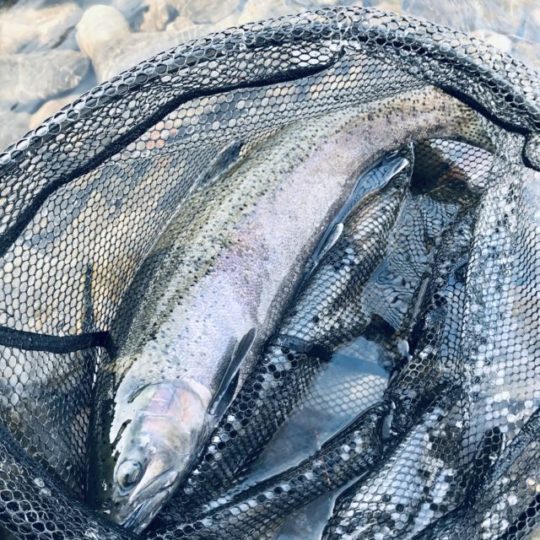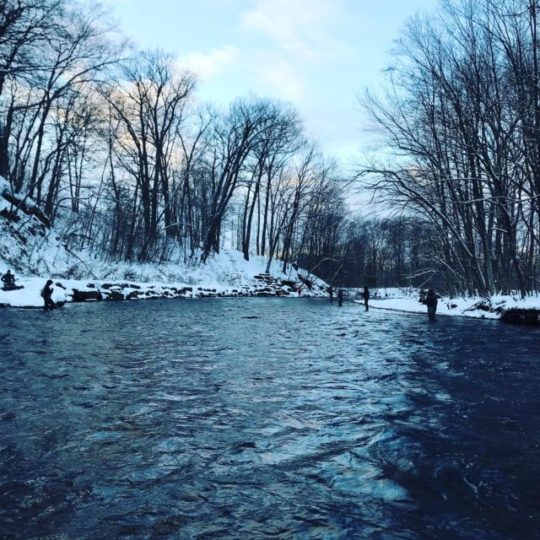I received some inquiries about the Euronymphing leader I used on last week’s steelhead trip to the Salmon River’s Lower Fly Zone. (Trip details here; my personal lessons learned here.)
Here it is, along with the fly line and backing I used:
- 150 yards of 30# backing
- Royal Wulff #6 Triangle Taper floating fly line (its delicate taper makes it ideal for tightlining; and, you need taper because running lines, such as Euronymphing competition ones, are illegal at the fly zones)
- 2’ of 20# Maxima Chameleon
- 2’ of .014” Cortland indicator mono, yellow/red
- 1’ of .013” Cortland indicator mono, white
- Tippet ring
- 6′ to 8’ 1x fluorocarbon
- Micro barrel swivel (on which is a three-inch piece of 1x with an overhand knot at the end to prevent the split shot from slipping off). I like black and very small swivels that look innocuous such as these from Raven
- 1′ to 2′ of fluorocarbon, 2x to 5x, depending on how much sun was out. And, the shorter tippet meant less foul hooking
Please know that all credit goes to UpCountry’s Torrey Collins, who used to guide at the Salmon River. He knows that water, and he knows what works. (There’s a great write-up of two of his steelhead tightlining rigs here.) The good folks at Thomas and Thomas also view him as one of the nation’s foremost experts on tightlining. So, he’s the real deal.
I used the above set-up with my 1086 Thomas and Thomas Contact six-weight (review here). It worked very well.
And, most important, I had many legitimate hook-ups and almost no foul hooking compared to my first foray to the river.
How could this be?
Well, the usual Salmon River fly fishing set-up is this: a long four-foot tippet length from the weight to the fly, heavy split shot, and swinging down and across. Unfortunately, it creates a lot of foul hooking.
The tightlining approach is different. You cast up and across, with less weight and a shorter tippet length, at fairly quick water that features some deep slots and underground boulders. You’re at feeding lies and prime lies. And, tightlining produces a very good dead-drift at those spots. You’re able to show to the fish an easy-to-get and tempting morsel.
Now, targeting fish at resting lies can work, of course. The steelhead are down deep and may opportunistically grab a swinging fly. But, it’s a low-probability game, and there’s a lot of risk of “lining” and “flossing” fish.
On my trip, for example, some guys who were swinging down and across with much weight were foul hooking a ton. This led to many lost flies and the need to re-rig. So, it was costly, both in terms of money and time. And, it wasn’t great for the fish.
Finally, here are some other observations:
- I also tightlined with my 10′ Orvis Helios 3D seven-weight “regular” fly rod. I used the leader formula above with regular floating fly line. It wasn’t as sensitive as the Contact rod, but it worked enough. The heavy line did create the dreaded “sag and drag,” but it was manageable if I did not have too much fly line out.
- Having both yellow/red and white indicator segments on the leader was great. It let me see the drift both during low-light and bright conditions.
- Weight amount was key. You want to get into the strike zone, but you do not want to be dredging and snagging a fish. The goal is to dead-drift an attractive morsel just above their heads. You want to tick the bottom just once or twice per drift. For me, that meant using a #5 , #7, or 3/0 split shot (I like the Eagle Claw removable ones).
Hope all this helps. I learned a ton at the Salmon River and was grateful to land some steelhead.
Last: a huge, huge shout-out to Torrey Collins!
Discover more from BlogFlyFish.com
Subscribe to get the latest posts sent to your email.



Also note that you cannot use more than 1/8 oz of weight in the fly zones. Great info. What style and size hooks did you use?
Mostly, scud-style hooks, #10 to #18.
Thanks… always tough to land these steelies!
I approve of this message, ha ha. Thanks for the shout out Jo, and everything you wrote here was spot on.
LOL. Thanks for the tremendous advice!
Nice write-up. Could use to see a photo of the euro-leader.
There’s not much to see, but this video could be helpful.
Super helpful post! I want to set up a similar tightline rig for Great Lakes steelhead and am looking for a suitable rod. Are there any other 10’+ 6wt rods optimized for tightline nymphing or is the Contact the only game in town? Thanks. Love the blog.
Thank you! The Contact is the only one I’ve heard of.
Great write up. What weight (mm) tungsten do you like for your point flies for ESN steelhead? I’m worried I’m tying stuff a bit too heavy. With the heavier leader and tippet, I figure I have to step up the weight a bit, but don’t want to go too heavy. Also, with some of my steelhead patterns that are larger in profile, like mop stoneflies and egg sucking leeches, I figure I need a bit more weight to have that larger profile sink properly. Thanks!
Thanks! It really depends on the current and the depth. I follow the guideline that Torrey Collins gave me: the rig should tick bottom at most once or twice per drift. You want the flies to be floating above the fish’s head.
Thanks! Since I posted this I got out and tried the stuff I tied. Didn’t get a steelhead, but got a nice Atlantic Salmon to eat a purple egg sucking leech I tied as an ESN point fly, using my new T&T Contact 2 6wt, and it was a great way to break that rod in! Now I’m hooked on this technique for large anadromous fish! By the way, the mop stonefly i was mentioning in my initial comment, despite having a large bead, was just too robust to sink fast enough. Did not tick bottom like you said. Might work better in lesser flows. Tight lines!
Congrats! I love the T&T #6–it is great for indicator nymphing as well.
nice article……a size 5 or 7 split shot seems like a lot. what were the flows that required these sizes. Thanks
Thank you! I don’t recall unfortunately but it was pretty high.
Hey thanks so much for these write ups! Super helpful. I’m getting ready for my first trip up to Pulaski this season – looking forward to the challenge of figuring this all out!
Question about the fly line as I do plan on fishing in the fly only zones, and typically I’ve been nymphing with a mono rig which of course I cannot use there. I notice that you’re using a 6wt floating line on your 7wt rod. I will be using an 8wt rod. Given that you must use a floating line, is there any reason why I shouldn’t use let’s say a 5wt or even lighter wt line to reduce the sag on the tight line? Wouldn’t a thinner line just act closer to a mono and since we’re not casting that floating line the wt doesn’t really matter – lighter the better? Curios on your thoughts! Thanks!
Hi! I use a 6-wt. fly line with my #6 Thomas & Thomas Euro rod. Per advice from Torrey Collins at UpCountry, and as mentioned in the blog post, I use the Royal Wulff #6 Triangle Taper floating fly line, which is thinner. Hope that helps.
The Salmon River is definitely a “unique” adventure. Good luck!
Thanks Jo! Yea saw that about the Wulff fly line, but I guess I was wondering whether even going with an even smaller Wulff line, like a 5 or 4 would work even better than the 6 given you’re just looking to go lightweight with that line as possible to reduce the sag.
Great question! Haven’t tried it but I suspect you’ll lose casting distance. So, just trade offs.
You may want to look into a Cortland Euronymphing fly line, which reputedly are quite thin
Thanks Jo! I might just try it and report back!
Are the cortland euronymphing fly lines legal on the fly fish only sections of the river?
Yes if you buy the DT line. What is illegal: running lines